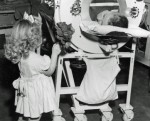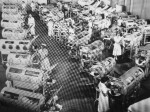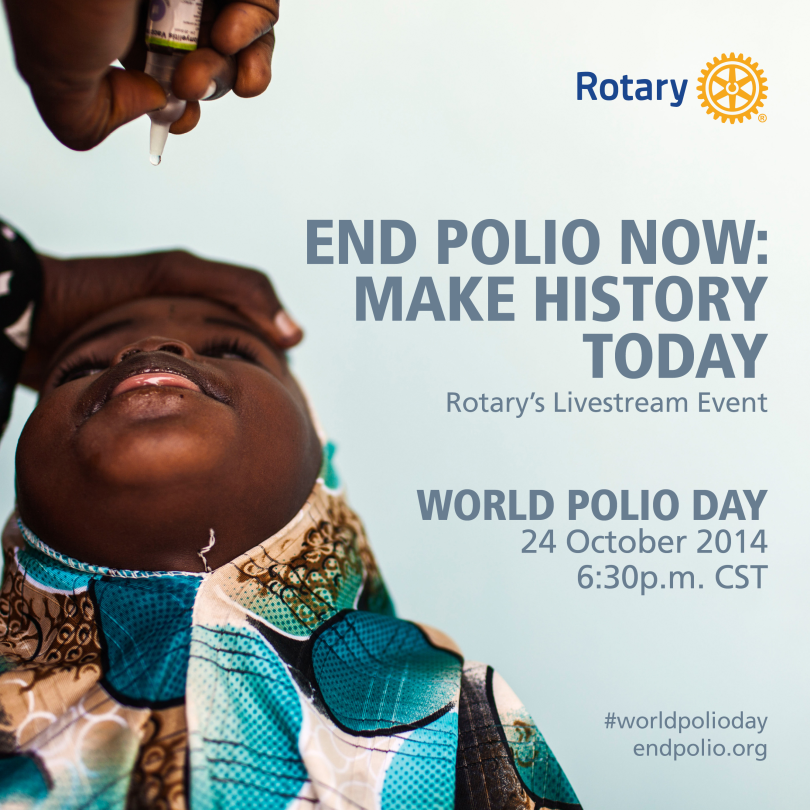A True Story of Loss, Survival and the Largest Public Health Experiment in History
Small-Town Michigan, 1951. An energetic seven year old boy named Michael experiences flu-like symptoms and headaches. They don’t go away. Within a week, he is feeble, lethargic, severely aching all over. His mother prays as his father notices his stiffness, his slowing reflexes, and they both know they must rush him to the doctor.

Big-City Hospital. Michael is in an iron lung. His mother’s fears have come true: Michael has polio, an extremely contagious virus for which there is no cure yet. She rushes between long-distance visits, caring for her toddlers at home, and daily mass. She is pregnant and has no idea what this means for her baby, but she knows she must visit her son. Once-strong, athletic Michael cries for her when she must leave – but he is not alone. He shares his hospital bay with countless other boys and girls suffering from the same illness. During his six-month hospital stay, he sees many of them come . . . and go.

In time, Michael’s condition improves. His parents dare to hope – will he survive polio? What are the statistics on that, exactly? There were about 28,000 total cases of polio in the US that year. They would not have known it yet, but Michael was the only child from his shared room to come home alive.
Until now, I had always focused on my Grandmother’s part in this story: how hard it must have been for her to raise my mother and aunts while caring for my Uncle Mike. I tried to imagine my brusque, silent-strong-type uncle hanging on to life. I can’t see it; I can only see him as I know him. I return to thoughts of my Grandma. I have always admired her strength and courage, her steadfast prayer, her fervent hope for all her children. Not to mention the fact that she went on to conceive twins as Michael was recovering, and she raised them all with style, patience and grace. But now I turn my thoughts to the Other Mothers.
Countless other mothers never had a chance to nurse their feeble children back to health, or to explain to their children what a saint Jonas Salk was for finding a lifesaving vaccine for this vicious disease. Thankfully, when the vaccine was released, those Other Mothers did eventually have the same opportunity my grandmother did to protect their other children from polio.

My mother recalls the release of the polio vaccine around 1955. Although she attended Catholic school, all the kids in the neighborhood had to go to the district school (Garfield Elementary, she still remembers it!) and wait in a long, winding line of scared children, all the while hearing the pain of the children receiving the injected dose of inactivated polio. My aunts still have scars from the injection site (this was before Sabin’s oral vaccine).
What those Other Mothers would have given had they known earlier about an effective vaccine that could have saved their children! What my grandma would have given to have had that vaccine before Uncle Mike contracted polio.
When my mother shared her memories of receiving the vaccine in the public school gym, I asked her if my rational, skeptical, SMART grandmother would have considered the side effects of a new vaccine, or if she would have simply jumped at the chance to avoid polio without thinking. I guess it was a dumb question. The results of years of extensive testing were published in JAMA, a well-respected peer-reviewed medical journal. It was then tested in the Francis Field Trial, the most extensive public-health medical experiment in history, including 1.8 million children throughout the United States. The experiment included – get this – an actual control group of children receiving no vaccine, and a group of children receiving a placebo. What?? Actual science! Peer-reviewed research! Double-blind studies! Over a million children!
Yet the science should not surprise you.
Of course it was extensively tested. And has been for decades. And even with side effects (VAERS keeping track of any report of adverse reaction, regardless of causation or verified correlation), my mother looked shocked that I would ask: to suggest that any potential individual reaction would be as terrible as thousands of young children growing weak, floppy, paralyzed and dying from polio. Yes, during the early trials, there were some serious side effects, but perfecting the vaccine provided immunity for everyone.
I grew up knowing my uncle had survived polio. Salk and Sabin were Saints in our house. Knowing this personal history as fact, I could never really ‘get it.’ I could not imagine what it was like for my grandmother. I couldn’t even try to imagine what it was like for my uncle, or the Other Mothers . . . or their children. I can’t imagine insurance companies selling “Polio Insurance” for newborns. We live in a time and place so far removed from these terrible diseases that we can’t even imagine how difficult, how painful, how widespread they can be.
It’s as if we’re weighing: Some vague, “highly contagious life-threatening” disease I’ve barely heard of? Or a vague, extremely low-risk side effect that might result in something I’ve heard of more recently?
#firstworldproblems.
We all want the best for our children. We need to be appropriately concerned about potential side effects or moral issues of using vaccines. However, most of us new parents today have never seen the widespread death and disease that had been common until now. (Hint: there’s a reason for that.) We are blessed to live in a time when we can – truly – eradicate these diseases completely. It only works if we all work together. If the March of Dimes had not raised funds, if Elvis, JFK and other celebrities had not become celebrity endorsers, if children like my uncle had not become literal poster children for the vaccine – if there were the level of vaccine-refusers we have today – polio would still be a threat to all of us.
Polio is considered eradicated in the Americas and Europe, and it is low-risk throughout the world. So why the article on a nearly eradicated disease? Because until it’s completely gone, we are all at risk. Because we are called to love our neighbors throughout the world. Because our weakened soldiers can carry it back from war-torn locations where workers are unable to distribute vaccines. Because we need to hear the truth, from someone who lived it. . . .Because sadly, many of the people who lived it, didn’t live to tell.


At left, polio poster children pose with Marilyn Monroe at Fashion Press Week. At right, lucky girl; creepy pandas. Evil stuffed animals aside, celebrity supporters encouraged the public to donate to the March of Dimes. My mother frequently told me about the time Grandma left the house after dinner. This occasion stuck in her mind because it was so unusual for Grandma to go out “on business” in the evening. What motivated her to do such a thing? She was collecting dimes from her neighbors to raise funds for the March of Dimes. Everyone went out that evening. Now that polio is eradicated here in the U.S., MoD focuses on prenatal care and many other groups have picked up the fight against polio around the globe, including Rotary International, with the goal of complete eradication by 2018.
“We’ve seen what can happen when there’s any break in the chain. In 2003 and 2004, northern Nigeria stopped vaccinating, even though they had endemic transmission. And boom! Twenty-one other countries that claimed and had proven to have eliminated polio became reinfected all over.”
Joel Breman, National Institutes of Health
 There are many ways that we here in the United States can help to eradicate polio. One is to celebrate World Polio Day on October 24th. World Polio Day was established to commemorate the birth of Jonas Salk, who led the first team to develop a vaccine against poliomyelitis. Use of this inactivated poliovirus vaccine and subsequent widespread use of the oral poliovirus, developed by Albert Sabin, led to the establishment of the Global Polio Eradication Initiative (GPEI) in 1988. Since then, GPEI has reduced polio worldwide by 99%.
There are many ways that we here in the United States can help to eradicate polio. One is to celebrate World Polio Day on October 24th. World Polio Day was established to commemorate the birth of Jonas Salk, who led the first team to develop a vaccine against poliomyelitis. Use of this inactivated poliovirus vaccine and subsequent widespread use of the oral poliovirus, developed by Albert Sabin, led to the establishment of the Global Polio Eradication Initiative (GPEI) in 1988. Since then, GPEI has reduced polio worldwide by 99%.
 What can you do? While it may be too late to host a World Polio Day event, you can join Rotary on World Polio Day, October 24, for a live-streamed global status update on the fight to end polio. Guests will include Global Polio Eradication Initiative partners, celebrity ambassadors, polio survivors and special guests. Tune in at 6:30 CT to watch the live event and take part in the conversation.
What can you do? While it may be too late to host a World Polio Day event, you can join Rotary on World Polio Day, October 24, for a live-streamed global status update on the fight to end polio. Guests will include Global Polio Eradication Initiative partners, celebrity ambassadors, polio survivors and special guests. Tune in at 6:30 CT to watch the live event and take part in the conversation.
Want to take a long-term approach to eradicating polio? Become a supporter of Shot@Life. Shot@Life builds on the UN Foundation’s 13-year legacy in global vaccine efforts as a leading partner in the Measles Initiative and Global Polio Eradication Initiative. By encouraging Americans to learn about, advocate for, and donate to vaccines, Shot@Life aims to decrease vaccine-preventable childhood deaths and give every child a shot at a healthy life.
So, what happened to my uncle? He not only survived; he re-learned to walk. He went on to regain his athletic build and play high school football. My grandmother often said it was nothing short of a miracle. He will turn 70 in a few weeks.
 After a lifetime of overcoming the odds, he now has been diagnosed with post-polio syndrome. Like chicken pox with shingles, there is a recurrent phenomenon for polio, starting approximately 15-35 years after fighting off the initial disease. As if surviving once was not enough. Thankfully, post-polio syndrome has not been as devastating, but my uncle experiences pain, weakness, muscle atrophy and difficulty with sleep, breathing and swallowing. It doesn’t keep him down: he still works, he started a karaoke business on the side, and he does a mean impression of Johnny Cash.
After a lifetime of overcoming the odds, he now has been diagnosed with post-polio syndrome. Like chicken pox with shingles, there is a recurrent phenomenon for polio, starting approximately 15-35 years after fighting off the initial disease. As if surviving once was not enough. Thankfully, post-polio syndrome has not been as devastating, but my uncle experiences pain, weakness, muscle atrophy and difficulty with sleep, breathing and swallowing. It doesn’t keep him down: he still works, he started a karaoke business on the side, and he does a mean impression of Johnny Cash.
He is thankful to be alive.
This guest post was written by two Rational Catholic Blog supporters- Julia Cali & Melody Butler
Julia Cali is a Catholic mom of four and a former Special Education teacher. Preventable illness is an issue close to her heart. She wrote this guest post because preventable illness is an issue close to her heart as demonstrated by her family’s history.
Melody Butler is a pediatric Registered Nurse and the founder of Nurses Who Vaccinate. Along with raising 4 children, taking long runs on the south shore of Long Island, and cantoring for her local Catholic Churches, she’s an avid advocate for public health. She’s a Shot@Life champion, ECBT Scientific Advisory Member, and Voices for Vaccines Parent Advisory Committee.

